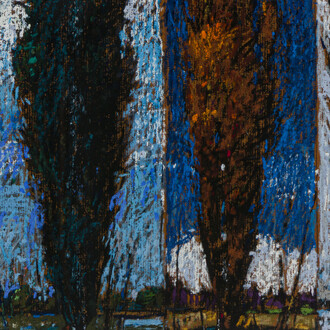Fedor Zakharov was born to a peasant family in 1919 in the village of Alexandrovskoye in the Smolensk region. Starting in 1936 Zakharov studied at Kalinin Industrial Art College in Moscow. With the outbreak of the Second World War, Zakharov was drafted for military service at the front lines, but instead he was assigned to serve in Moscow, where he created posters and drawings for the Red Army’s war efforts. During this time, in 1943, Zakharov entered the Surikov State Art institute in Moscow from which he successfully graduated in 1950.
Zakharov soon discovered the Crimea and its rich, bright, multicolored nature had a great influence on him. Here, Zakharov decided to seriously devote himself to landscape painting. The early works of Zakharovs are naive, fresh, and often given to ornamentation, but soon he started using his palette with more variety, avoiding unnatural color contrasts. He worked hard perfecting his technique, often in plein air because he could not yet afford a studio. His small apartment was very close to the Black Sea where he spent seven years painting in the ports, on the beach, and in the town. He worked almost every day, in all seasons and in any weather, never inventing subjects, always paying attention to the land and what it told him.
As Zakharov matured through the nineteen sixties his focus shifted. His style ever more successfully depicted the defining components of light and air. His strokes are larger, confident, more masterful and contrasting, the canvases suggestive of having been painted in a single breath.
Zakharov’s remarkable gifts and achievement could not go unnoticed by the official authorities. In 1970 Zakharov was nominated Honored Painter of the Ukraine and in 1978 he was again honored as the Peoples Painter of the Ukraine. He was also awarded the Red Banner of Labor and the Sign of Honor, the highest distinctions awarded to regular citizens. In 1987, he was awarded the State Prize after Shevchenko. It is amazing that Zakharov received these considerable acknowledgements in spite of the fact that he had never followed the official USSR dogmatic style of socialist realism, the artist was never a member of the Communist Party, and he never allowed his art to be used as the instrument of ideological and party propaganda. He remained, throughout his career and his entire life, devoted to art, to his painting, and to the advancement of all painting in Russia. He is remembered today, throughout Russia, simply as one of the greatest painters of his time.













